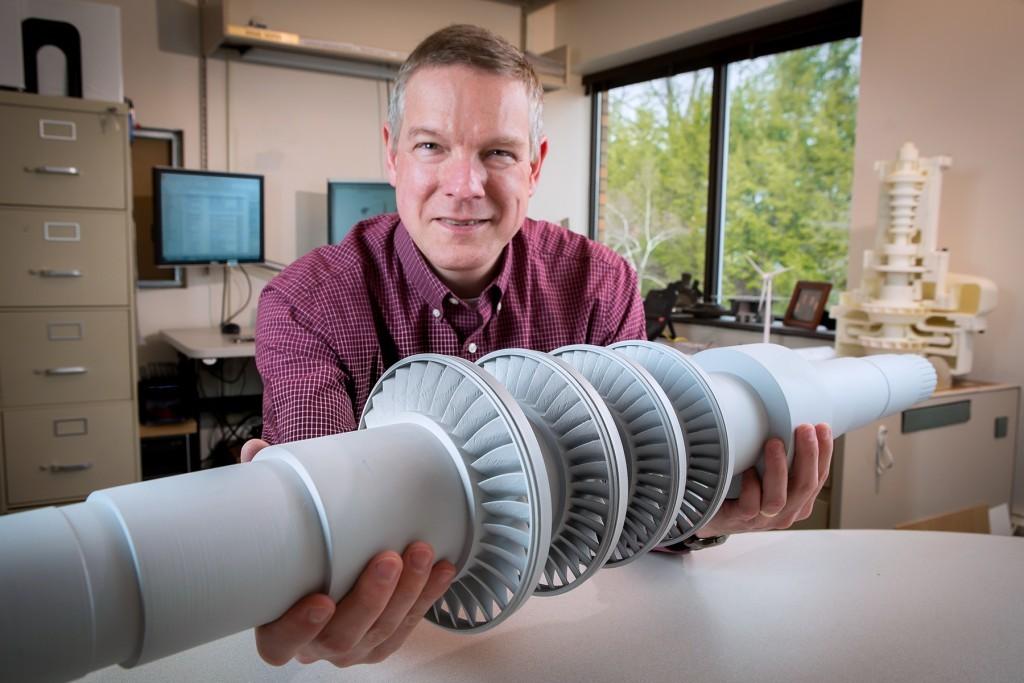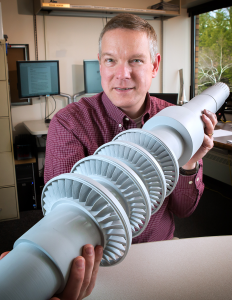Latest on the my-invention-is-smaller-than-yours catwalk is a compact turbine that despite weighing only 150 pounds can generate sufficient electricity to power 10,000 homes. To give you an idea of what that means in terms of reduction in size, current steam turbines with similar output capabilities are ten times larger. Not only is the newer turbine significantly smaller, it also operates with a 10% increase in efficiency at turning heat into electricity. A further benefit is the system’s ability to quickly power up to quickly generate electricity during peak demand, needing only a couple of minutes to come online in comparison to the half an hour necessary for steam-powered turbines.
This diminutive dynamo, developed at GE Global Research, works using the power of carbon dioxide that is heated to such a high temperature, in this case up to 700°C, it becomes what is known as a supercritical fluid. Rather than using steam to give it spin, this supercritical fluid operates in the realm where the difference between gas and liquid virtually disappears allowing it to generate power in an extremely efficient manner. After passing through the turbine, the supercritical material is cooled, repressurized, and sent through again in a endless repeated cycle that keeps the turbine moving.

Doug Hofer of GE Global Research holds a 3D printed prototype of the turbine [Image: GE Global Research]
 The research is, as of yet, in its early stages, but 3D printing has been a vital tool for study and iteration in the development process. While the final ‘minirotor’ would be high-strength metal, it would have been nearly impossible to advance as quickly without the capabilities of 3D printing to provide rapid prototyping and process oriented models.
The research is, as of yet, in its early stages, but 3D printing has been a vital tool for study and iteration in the development process. While the final ‘minirotor’ would be high-strength metal, it would have been nearly impossible to advance as quickly without the capabilities of 3D printing to provide rapid prototyping and process oriented models.
The next step in the development of this technology is to determine the possibilities for scaling it up to the 500 megawatt range, the capacity necessary to power a large city. In addition to the cleaner use of CO2 to produce power, the reduction in the footprint of these generators adds up to thousands of acres of landscape that need not be dedicated to simply holding generators. As Doug Hofer, developer of the minirotor explained:
“This compact machine will allow us to do amazing things. The world is seeking cleaner and more efficient ways to generate power. The concepts we are exploring with this machine are helping us address both. With energy demand expected to rise by 50 percent over the next two decades, we can’t afford to wait for new, cleaner energy solutions to power the planet. We have to innovate now and make energy generation as efficient as possible. Programs like those we are working on with the US Department of Energy are helping us get there.”
What do you think of this new technology? Discuss in the GE 3D Printed Turbine forum over at 3DPB.com.
Subscribe to Our Email Newsletter
Stay up-to-date on all the latest news from the 3D printing industry and receive information and offers from third party vendors.
You May Also Like
Creality Begins Selling HALOT-MAGE S: Setting New Standards in Precision 3D Printing
Creality, a leading innovator in consumer-grade 3D printing technology, proudly introduces the HALOT-MAGE S, the latest breakthrough in high-resolution 3D printing. With its cutting-edge features and user-centric design, the HALOT-MAGE...
Farsoon Showcases Comprehensive 3D Printing Solutions, Automation, and More at TCT Asia
This year’s TCT Asia event showcased just how much the Asian additive manufacturing (AM) market has grown, with Eplus3D’s 64-laser metal 3D printer alone acting as a synecdoche for China’s...
Creality Launches Ender-3 V3 Plus: Bigger CoreXZ for Unprecedented Performance
Embracing a journey of innovation and excellence, Creality’s Ender-3 series has established a distinguished path in the field of 3D printing. From the entry-level Ender-3 V3 SE to the feature-rich...
Laser Wars: Eplus3D Unveils Metal 3D Printer with up to 64 Lasers
Now that the laser wars in the powder bed fusion (PBF) space have, for the most part, moved to China, original equipment manufacturers (OEMs) there are in fierce competition. Eplus3D...


































